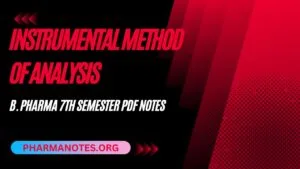Instrumental Methods of Analysis – B. Pharma 7th Semester PDF Notes

Instrumental Methods of Analysis 7th Semester Notes
Scope: Instrumental Methods of Analysis deals with the application of instrumental methods in qualitative and quantitative analysis of drugs. This subject is designed to impart fundamental knowledge on the principles and instrumentation of spectroscopic and chromatographic techniques. This also emphasizes theoretical and practical knowledge of modern analytical instruments that are used for drug testing.
Objectives: Upon completion of the course the student shall be able to
1. Understand the interaction of matter with electromagnetic radiation and its applications in drug analysis
2. Understand the chromatographic separation and analysis of drugs.
3. Perform quantitative & qualitative analysis of drugs using various analytical instruments.
Instrumental Methods of Analysis Course Content:
Instrumental Methods of Analysis UNIT –I
Electronic transitions, chromophores, auxochromes, spectral shifts, solvent effect on absorption spectra, Beer and Lambert’s law, Derivation, and deviations.
Instrumentation – Sources of radiation, wavelength selectors, sample cells, detectors- Photo tube, Photomultiplier tube, Photo voltaic cell, Silicon Photodiode.
Applications – Spectrophotometric titrations, Single component, and multi-component analysis
Theory, Concepts of singlet, doublet, and triplet electronic states, internal and external conversions, factors affecting fluorescence, quenching, instrumentation, and applications of Fluorimetry
Instrumental Methods of Analysis UNIT –II
Introduction, fundamental modes of vibrations in polyatomic molecules, sample handling, factors affecting vibrations
Instrumentation – Sources of radiation, wavelength selectors, detectors – Golay cell, Bolometer, Thermocouple, Thermister, Pyroelectric detector, and applications
Flame Photometry– Principle, interferences, instrumentation, and applications
Atomic absorption spectroscopy– Principle, interferences, instrumentation, and applications
Atomic emission spectroscopy– Principle, interferences, instrumentation, and applications
Nepheloturbidometry– Principle, instrumentation, and applications
Instrumental Methods of Analysis UNIT –III
Introduction to chromatography
Adsorption and partition column chromatography– Methodology, advantages, disadvantages, and applications.
Thin layer chromatography- Introduction, Principle, Methodology, Rf values, advantages, disadvantages, and applications.
Paper chromatography– Introduction, methodology, development techniques, advantages, disadvantages, and applications
Electrophoresis– Introduction, factors affecting electrophoretic mobility, Techniques of paper, gel, capillary electrophoresis, applications
Instrumental Methods of Analysis UNIT –IV
Gas chromatography – Introduction, theory, instrumentation, derivatization, temperature programming, advantages, disadvantages, and applications
High-performance liquid chromatography (HPLC) – Introduction, theory, instrumentation, advantages, and applications.
Instrumental Methods of Analysis UNIT –V
Ion exchange chromatography- Introduction, classification, ion exchange resins, properties, mechanism of the ion exchange process, factors affecting ion exchange, methodology, and applications
Gel chromatography- Introduction, theory, instrumentation, and applications
Affinity chromatography- Introduction, theory, instrumentation, and applications
Other Topic related to Instrumental Method of Analysis:
Applications of Instrumental Methods in Pharmaceutical Analysis
Importance of Instrumental Methods in Pharmaceutical Analysis
Ultraviolet visible UV vis spectroscopy
Qualitative applications of UV Visible spectrophotometry
Dispersive IR spectrophotometers
Fourier Transform Infra-red spectrophotometers
Sample handling and interpretation of IR spectra
Spectroscopy and Electromagnetic Spectrum
Instrumental Methods of Analysis 7th Semester PDF Notes
Instrumental Methods of Analysis (Practical)
1. Determination of absorption maxima and effect of solvents on absorption maxima of organic compounds
2. Estimation of dextrose by colorimetry
3. Estimation of sulfanilamide by colorimetry
4. Simultaneous estimation of ibuprofen and paracetamol by UV spectroscopy
5. Assay of paracetamol by UV- Spectrophotometry
6. Estimation of quinine sulfate by fluorimetry
7. Study of quenching of fluorescence
8. Determination of sodium by flame photometry
9. Determination of potassium by flame photometry
10. Determination of chlorides and sulfates by nephelo turbidometry
11. Separation of amino acids by paper chromatography
12. Separation of sugars by thin-layer chromatography
13. Separation of plant pigments by column chromatography
14. Demonstration experiment on HPLC
15. Demonstration experiment on Gas Chromatography
Instrumental Methods of Analysis Notes Recommended Books (Latest Editions)
1. Instrumental Methods of Chemical Analysis by B.K Sharma
2. Organic spectroscopy by Y.R Sharma
3. Textbook of Pharmaceutical Analysis by Kenneth A. Connors
4. Vogel’s Text book of Quantitative Chemical Analysis by A.I. Vogel
5. Practical Pharmaceutical Chemistry by A.H. Beckett and J.B. Stenlake
6. Organic Chemistry by I. L. Finar
7. Organic spectroscopy by William Kemp
8. Quantitative Analysis of Drugs by D. C. Garrett
9. Quantitative Analysis of Drugs in Pharmaceutical Formulations by P. D. Sethi
10. Spectrophotometric identification of Organic Compounds by Silverstein

Please complete the notes of instrumental method of analysis and pharmacy practice subject of bpharma 7th sem